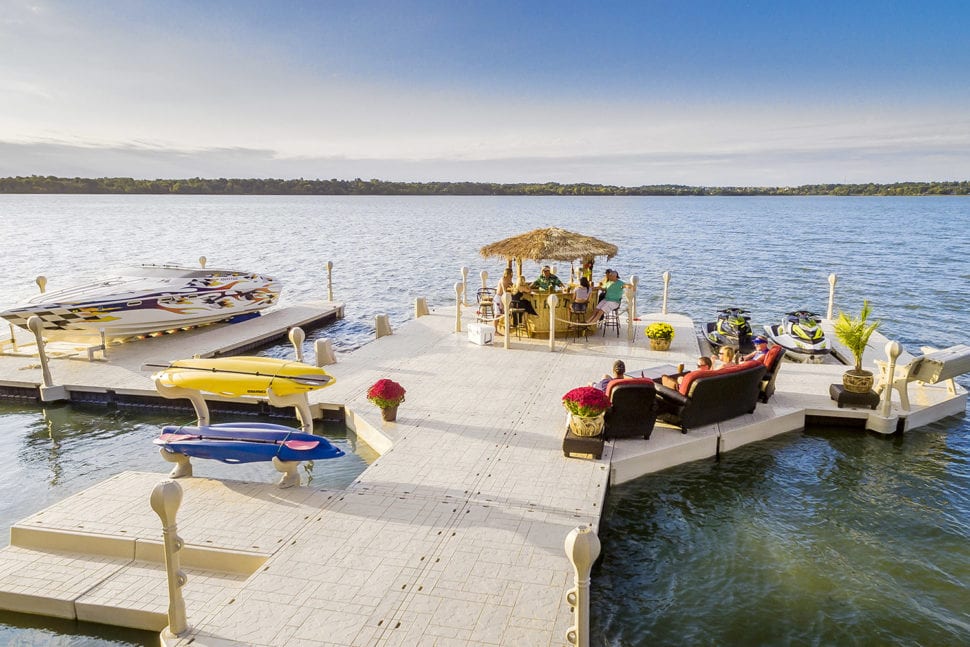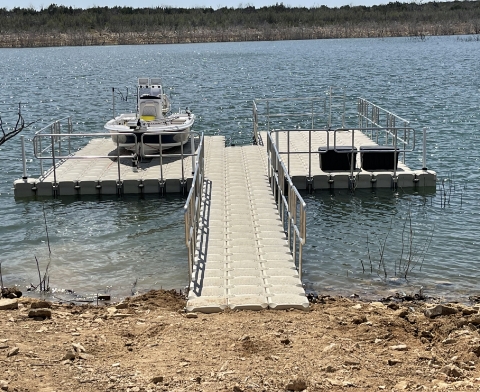Upgrade Your Waterside With Resilient Floating Docks
Updating your waterfront with resilient floating docks can significantly improve both performance and aesthetics, offering a flexible option for numerous water tasks. With a range of materials offered, consisting of low-maintenance choices and typical timber, selecting the best dock can enhance your personal design and fulfill practical needs.
Benefits of Floating Docks
Floating docks deal a multitude of benefits that improve their charm for numerous maritime applications. Among the main benefits is their flexibility to transforming water levels - floating dock builder. Unlike traditional fixed docks, floating docks fluctuate with the trend, ensuring constant ease of access for boats and boat despite environmental conditions. This attribute dramatically decreases the danger of damage to vessels, as they continue to be safely moored also throughout fluctuations in water deepness.
Additionally, floating docks are simpler to install and move, supplying flexibility for short-lived or seasonal usage. Their modular layout enables for customization to fit certain demands, whether for personal marinas, residential watersides, or commercial applications.
Additionally, floating docks produce very little disturbance to the water setting, preserving regional ecological communities and decreasing the probability of disintegration. They also supply boosted safety and stability for individuals, as their resilient nature supplies a more forgiving surface than stiff frameworks.
In addition, floating docks can promote a diverse variety of activities, such as angling, swimming, and entertainment boating, making them a beneficial asset for waterfront advancement. Their adaptability and practicality make floating docks a preferred choice for a range of marine jobs.
Selecting the Right Products
Choosing proper products for floating docks is crucial to their long life, efficiency, and general efficiency. When selecting materials, think about aspects such as environmental exposure, maintenance needs, and architectural honesty. Usual products include wood, plastic, aluminum, and composite alternatives, each offering distinctive advantages and downsides.
Wood, while aesthetically pleasing, requires regular upkeep to stop rot and degeneration. Pressure-treated wood can enhance resilience, but it may still succumb to water damages gradually. Plastic floats, frequently made from high-density polyethylene, are resistant to deterioration and need very little upkeep, making them an attractive selection for low-maintenance applications.
Light weight aluminum is one more viable alternative, understood for its strength and light-weight residential or commercial properties. It is immune to corrosion and can stand up to severe climate condition, although it may be more costly than other products. Composite products combine the very best attributes of wood and plastic, supplying a low-maintenance and resilient choice that simulates the appearance of timber without the connected downsides.
Eventually, the choice of material must line up with the planned use, environmental factors to consider, and budget restraints, ensuring a practical and sturdy floating dock that meets your particular needs.
Installation Refine Introduction
The successful installment of a floating dock relies upon careful planning and implementation, guaranteeing that it runs effectively in its designated setting. The initial step includes analyzing site conditions, consisting of water deepness, shoreline functions, and dominating climate patterns, which will inform the dock style and anchoring system.
Complying with the site evaluation, the following stage is to prepare the floating dock parts. This includes setting up the structure, securing floats, and connecting any kind of necessary hardware. It is critical to ensure that all connections are waterproof and durable to hold up against marine conditions.
As soon as the dock is constructed, the installation process commences with positioning the dock in the water. This can involve a crane or other lifting equipment, especially for bigger frameworks. Correct placement is essential for functionality and safety.

Maintenance Tips for Longevity
Routine maintenance is necessary for guaranteeing the long life and ideal efficiency of a floating dock. To attain this, begin with regular evaluations at the very read here least two times a year, focusing on the stability of the dock's framework, including the flotation protection devices and linking hardware. Search for indicators of deterioration, damage, or wear, and attend to any kind of problems promptly to avoid more wear and tear.
Cleansing is another vital facet of upkeep. Remove debris, algae, and barnacles from the dock's surface to stop slippery problems and keep aesthetic appeal. Use a light cleaning agent and a soft use this link brush to stay clear of harming the dock's products.
Furthermore, make certain that the dock is correctly anchored and protected to stand up to seasonal adjustments in water degrees and weather. Check the anchoring system for security and make adjustments as necessary.
Enhancing Your Outdoor Aesthetic
To create a visually appealing outdoor space, incorporating a floating dock can substantially improve the general visual of your beachfront residential or commercial property. Floating docks are not only functional but can additionally act as a striking prime focus that enhances the all-natural surroundings - floating dock services. Readily available in different materials and designs, these docks can be tailored to match your residential property's architectural design and landscape
The enhancement of ornamental components, such as incorporated lights or elegant railings, even more boosts the dock's aesthetic charm. Consider making use of all-natural wood coatings, which mix effortlessly with the atmosphere, or choosing modern-day products like aluminum or composite outdoor decking that provide a sleek, modern look.
Purposefully putting planters or seating areas on or around the dock can develop inviting rooms that motivate relaxation and satisfaction of waterside sights. Furthermore, incorporating shades and textures that balance with your landscape will produce a natural visual throughout your exterior location.

Verdict

Updating your waterfront with long lasting floating docks can dramatically enhance both performance and aesthetics, supplying a functional service for various water tasks. Unlike typical fixed docks, floating docks increase and autumn with the trend, guaranteeing constant accessibility for watercrafts and watercraft regardless of environmental conditions.Picking ideal materials for floating docks is crucial to their durability, performance, and overall efficiency.As soon as the dock is assembled, the setup process begins with placing the dock in the water.In recap, floating docks deal numerous advantages, including versatility to water level modifications and a selection of product alternatives.